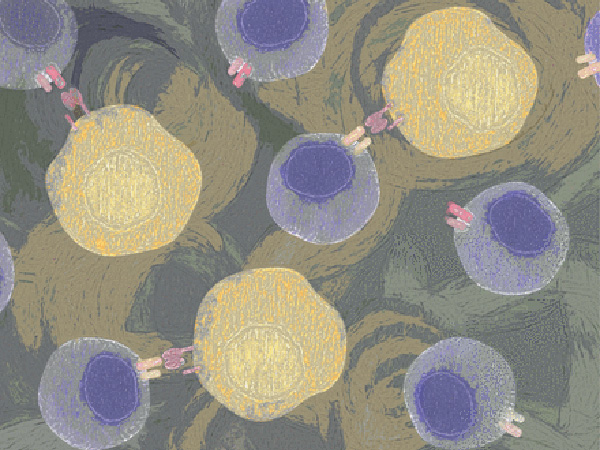AACR Hosts Meeting Focused on Liquid Biopsy in Cancer
In a spotless futuristic lab, a doctor takes a single drop of blood from someone and places it in a machine. After a brief bit of whirring and analysis, an up-to-date, comprehensive overview of the patient’s health pops up on a screen. An alert indicates the detection of some precancerous cells, but the doctor explains that because of how early they caught the disease, it should be entirely curable.
Though our science is not there yet, that’s exactly the type of future the field of liquid biopsy hopes to bring about. And from November 13-16, at the AACR Special Conference in Cancer Research: Liquid Biopsy: From Discovery to Clinical Implementation in San Diego, the leaders in this space will share their vision for turning that science fiction scene into reality.
Liquid biopsy has immense potential in cancer. By sampling a patient’s blood, doctors can gain a wealth of biological information, including about the presence and identity of the cancer cells. This, in turn, can help guide doctors’ decision making—both before, during, and after treatment—to improve their patients’ chances of survival and quality of life.
With respect to detection, there are already liquid biopsy technologies approved by the U.S. Food and Drug Administration (FDA) to screen for prostate cancer and colorectal cancer by measuring tumor-related biomarkers in the blood. While effective at picking up advanced cases, more work remains to improve their ability to detect low burden, early-stage cancers.
After a cancer diagnosis, liquid biopsy can be used to determine patient selection and eligibility for certain treatments. Then, during treatment, doctors can monitor patients’ response, or lack thereof, and adjust care accordingly.

“Stage 2 colon cancer is an excellent example where liquid biopsy analysis can be used to de-escalate treatment,” said conference cochair Klaus Pantel, MD, director of the Institute of Tumor Biology at the University Medical Center Hamburg-Eppendorf. “If we can really show that the patients have no traces of tumor in their blood anymore, there appears to be no need for subsequent chemotherapy.”
Thus, patients no longer at risk could stop treatment and be spared both the potential side effects and financial costs. At the same time, annual liquid biopsy checkups could keep an eye out for any signs of relapse.
“I like this application for de-escalation,” noted Pantel, “because it can improve care by being applied to existing therapies.”
The most successful current liquid biopsy approaches utilize circulating tumor cells (CTCs) and circulating tumor DNA (ctDNA) in the blood, but the conference will also focus on alternative modalities with potential significance. Beyond CTCs and ctDNA, cell-free RNA, exosomes, and even whole proteins can reflect important biomarker information. Neither is liquid biopsy limited to the blood: bodily fluids like saliva, sweat, cerebrospinal fluid, and urine can also hold insights that can be acquired in a less invasive way.
We spoke with Pantel to learn more about the meeting, and both the present and the future of liquid biopsy in cancer.
The theme of this meeting is “From Discovery to Clinical Implementation,” which reflects the progress made in liquid biopsy technologies and how they’re starting to impact patients’ lives. What’s happening in the field right now that makes this meeting so important, and what sessions most intrigue you?
Pantel: It’s very exciting because we are at the doorstep of clinical implementation. We have the first applications accepted by some of the healthcare institutions in the United States and Europe, but we have many more applications of great interest for patients and the public and that includes the early detection of disease, early detection of relapse, but also getting information on what kind of therapy is the best for patients with more advanced diseases, where in many instances you cannot take a tissue needle biopsy because the metastasis is not accessible or the patient is not in good condition. So, I think it is a real paradigm change in the diagnostic landscape of oncology.
We have assays that are much more sensitive than current imaging technology, so we can detect disease and relapse earlier and also get qualitative information about the type of disease and molecular changes relevant to therapy. That gives us a real big advancement in oncology, and that’s why I think there is great excitement about liquid biopsy.
ctDNA fragments are in the lead of clinical implementation, but other analytes or biomarkers, such as CTCs or exosomes may also be clinically useful. Even the good old proteins, the whole protein analysis technology has really improved over the past years, so proteins will probably enter this stage very soon. It’s super exciting that we have now a multiomics approach to get as much information out of a blood sample as possible. That may include not only how the tumor responds, but also the patient’s immune system response, which in the case of immunotherapies is very important.
We are very excited for this meeting because we tried to make it as comprehensive as possible to include the input of researchers and clinicians from different angles. The meeting contains different sessions on different liquid biopsy markers and on how to bring them all together, maybe with data analysis that relies on artificial intelligence.
What are the biggest challenges in the field right now and how are new technologies and approaches helping to address those challenges?
Pantel: There are challenges from the technology point of view that will be overcome, I’m very optimistic about that. For example, if you want to detect relapse earlier, let’s say in lung cancer—there have been excellent studies, but they also showed that we miss the minimal residual disease (MRD) in some of these patients, so the negative predictive value was not so great. But new technology that’s much more sensitive could now pick up very, very low amounts of ctDNA, and that was relevant to patient outcomes.
Low concentrations of CTCs and ctDNA has always been a technical challenge. Most assays operate at the lowest level of detection. And that’s tricky because you also need to show that the day-by-day variation is accounted for—that there’s not a Monday through Friday difference—and that you have a standardized workflow. Our European consortia are now working to develop standards using DNA that can be added to provide quality assurance. Even when your test works and remains sensitive, this kind of quality assurance is super important if you want to bring technologies from the discovery stage into clinical practice.
It’s also a challenge to get liquid biopsy technologies approved for the clinic. When we see peer-reviewed publications about promising devices, many people believe that this will now be taken by somebody to bring into clinical practice, but that single somebody doesn’t always exist. It’s not like drug development, where the company that develops it takes it through the process to get it approved by the FDA, so it becomes available for patients. With diagnostics, there is not always a clear path as we have for drugs, with different phases of clinical trials.
At the conference, we will be discussing this important topic and hear from experts about a variety of new technologies for liquid biopsy analyses, and how to get them into the clinic as soon as possible.
With liquid biopsy being such an important emerging area of cancer research, what career opportunities are there for young investigators in the field and how might this tailored meeting provide value?
Pantel: First off, young scientists will get a wonderful overview of what is really cooking about future developments. It will also be a great opportunity for them to interact with both key opinion leaders and representatives from a variety of companies.
One of the most important things for young investigators though, is to spot where the unmet needs are, because in the future you want to do something new. You want to develop something that is not there. At such a focused meeting you can get a good idea of what are the current challenges and hear discussion on how to overcome them. This could be a wonderful start for setting up your lab or your own research project.
When I started many years ago, I only had one good question: If you get relapse in breast cancer after 10 years, where were the tumor cells? We didn’t have the technology to detect them back then, so people told me no, we cannot see them in the blood, we cannot see them anywhere. A relapse doesn’t come from the outside like an infectious disease, so where does it come from? That one question started my whole career.
The ultimate goal is to have a simple, noninvasive test that could help detect a cancer in its earliest stages, when a patient would have the highest likelihood of surviving. How close are we to something like that? And when you look at the horizon over the next 5 to 10 years, what excites you most about the future of the field?
Pantel: For early detection, we have made enormous progress, but we still miss patients with early-stage cancers, when they’re most treatable. We probably still have to work on the sensitivity of the analysis, but at the same time we also have learned that there are background mutations from normal cells that accumulate as we get older. So, for me, it’s still an open question whether the ctDNA approach alone will deliver the optimal sensitivity and specificity that’s really needed to detect very early-stage tumors. We have so many other biomarkers now that I believe more in a composite biomarker approach.
What excites me most is the field of MRD. Tumors in most patients respond to initial treatment, but then the key question is, is there residual tumor or not? Will it come back or not? If we can establish reliable technologies, we can design new clinical studies to identify those patients with residual tumor cells who are still at risk of relapse. And I feel that we can really tackle that now.
Right now, we mostly treat patients at the beginning of the disease and when they have metastasis, and we just wait and hope in between that timeframe. But now, with the surveillance of blood analysis, we could monitor patients who are potentially on a path to metastasis. Such analysis could also help us understand what is required to get rid of those residual tumor cells and make progress in improving patient outcomes.
Editor’s note: Registration is open for the AACR Special Conference: Liquid Biopsy.



